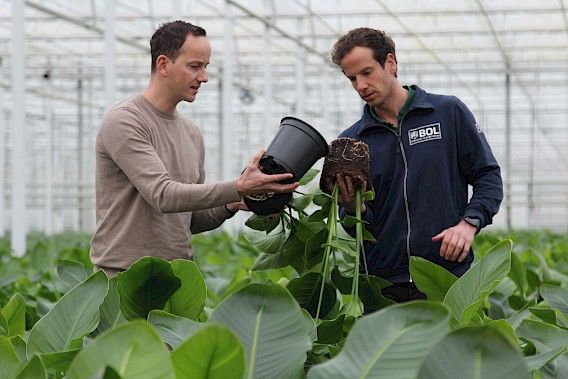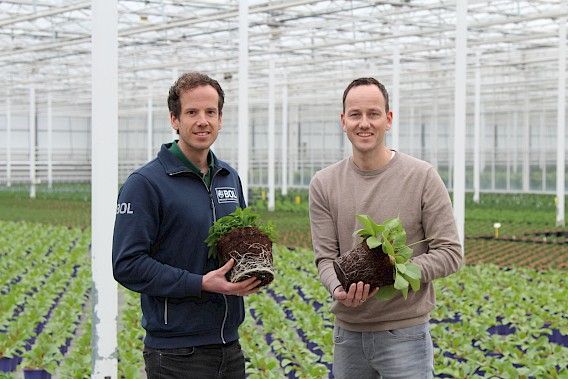Delighted customer with 100% peat-free compost
Since 2022, Plantanious from Kwintsheul and Persoon Potplanten from De Lier have formed a single entity with a cultivation area of 9 hectares. Together with their cousin and business partner Quint Persoon, twin brothers Freek and Joost Jansen grow green houseplants and flowering garden plants in pot sizes ranging from 17 to 35 cm. They serve customers across Europe, including the United Kingdom.
"As of January 1 next year, some British retailers will no longer accept plants with peat in the substrate," says Freek Jansen. "Although the regulations for Europe are less strict, we want to retain those customers. So, in the summer of 2022, we took the plunge."
Various Consequences
The company took this step together with its regular supplier, BOL, a substrate specialist from Hoek van Holland. "Over 2.5 years, we tested various peat-free mixtures from different suppliers. BOL's substrate proved to be the best," Jansen recalls.
Bram van Paassen, co-owner of the substrate company, adds, "We tested all crops, growing durations, and seasons. Switching to a peat-reduced or peat-free substrate always has consequences for cultivation. The product must not suffer, so careful adjustments are needed in potting, fertilization, and irrigation."
Getting It Right from the Start
For Van Paassen, Plantanious was the first customer to make the switch all at once. "It was quite exciting, even for us," he admits. "Fortunately, we got it right immediately. Wood fiber, coconut fiber, coconut grit, and bark are the main ingredients. We quickly abandoned green compost because it led to an unstable pH in longer cultivation cycles. For bedding plants, this is less of an issue, and green compost can be included in the mix."
Better Control
"We are very satisfied with the mixture we now use," Jansen summarizes. "It's slightly airier than the peat-based mixes we used to have. The pot drains well and stays less wet at the bottom. I find it easier to manage. Coconut grit provides excellent capillary action, allowing us to set a lower water level on the concrete floor. Potting also works smoothly. Regarding fertilization and nutrient analyses, we have observed no issues. We conduct soil tests every five weeks to ensure we stay on track. Over the past year, we haven’t encountered any problems."
From Five to One Mixture
Since January 1, Plantanious has been growing exclusively in fully peat-free substrate. An added advantage is that their entire product range thrives on just one recipe. In the 'peat era,' Plantanious used five different mixtures. "It's great to have just one mix now; it's more efficient for space usage, logistics, and communication with customers who want to know exactly what's in our substrate," says Jansen. "It’s also beneficial that we could stay with BOL. They may not be a large player, but that is precisely their strength. They have short lines of communication, quick decision-making, and extensive knowledge and experience."
Environmental Footprint Matters More Than ‘Peat-Free’
‘Peat-free’ is often considered synonymous with sustainability. Bram van Paassen sees it more nuanced. "The substrate transition is about reducing environmental impact throughout the substrate's life cycle. To do this, you need to evaluate all raw materials and the chain-wide effects of using a particular substrate. This includes not only cultivation but also plant loss in the supply chain. Once all factors are clear, a Life Cycle Assessment (LCA) environmental footprint can be determined. Industry-wide efforts are underway on this. I sincerely hope that, in the near future, we can have a more fact-based discussion, including in the British market."

